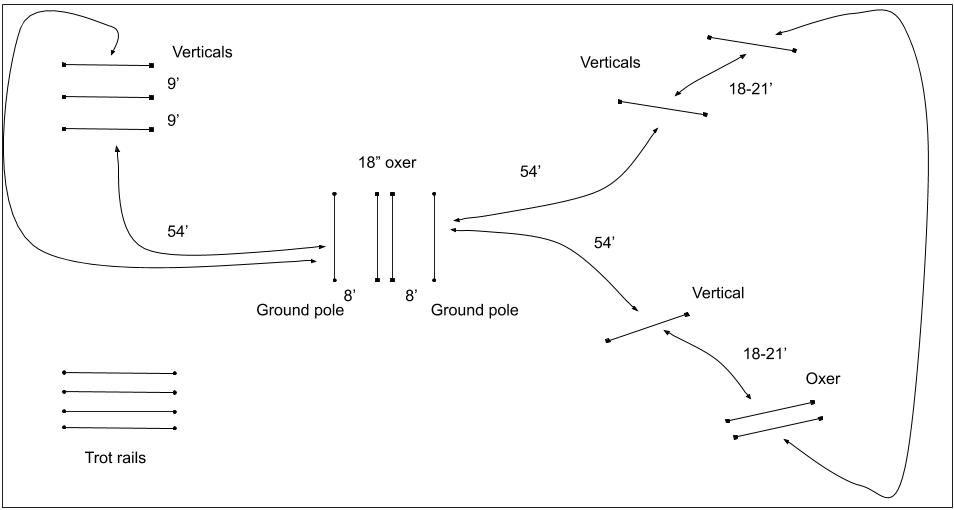Jumper Nation Clinic continues with a new exercise to try at home. Jumper Nation has teamed up with top, respected riders who we love for both their horsemanship and their creativity with exercises they use at home. Each week, we’ll be bringing you a new grid or exercise to try at home. You’ll be primed and ready for the show ring when we are able to get out there again!
This week’s featured grid is courtesy of Doug Payne and DP Equestrian.
Doug Payne is a 5* event rider, Team USA PanAm gold medalist, and a Grand Prix show jumper.
 Diagram courtesy Doug Payne.
Diagram courtesy Doug Payne.
This exercise consists of:
- Trot poles set on the side of the arena
- A low (approximately 18″) oxer in the middle of the ring, with ground poles set 8′ to either side
- Bending line, approximately 54′ with some flexibility from the oxer to a set of 3 verticals set 9′ apart (bounces)
- On the other side of the oxer, two bending lines: One approximately 54′ to a set of verticals 18-21′ apart; another to a vertical-oxer line set also 18-21′ apart
- It is okay to start with all rails on the ground instead of jumps. Keep the jumps low for confidence
Doug Payne explains: “This exercise is all about the angles and footwork. It can be either mentally challenging and physically easy, or mentally easy and physically challenging – that way, you won’t get into trouble. You can do the exercise in parts and put it together as you go. I have the oxer set up in my ring every day and like to do a figure 8 over it or a circle, then move on to other parts of the exercise. You can also start with even just the trot rails, then move on and do the trot rails to the bounces.
“When setting up the angled jumps, use less angle with young horses. Also, if you’re using placing rails and the oxer is very small, you may need to roll them in to 7′ instead of 8′. You can even bring all of these jumps down to be completely rails on the ground.”
The beauty of this exercise is that when the horses, land, they have something to do. They learn that it is to their advantage to land in a good shape, go straight, and listen to the rider. They also quickly learn that they need to be aware of their feet. This exercise won’t prevent the horse from making mistakes; it encourages him to be careful and to focus. The horses learn that the rider is there to help them out, but if they run through the rider or aren’t listening, there is a price to pay (an uncomfortable jump, a rail, etc). The overarching goal is for the horse to focus without losing confidence (hence why the jumps should be kept on the lower side).
Doug offers the following specific additional suggestions:
- Hot horses. Jump the oxer from the canter, then go straight to the bounce, then to the trot poles.
- Lazy horses. Throw things at them quickly. Be mindful if they pause or stall off the ground. You can even “bait” them into being lazy (just sit there), and then give them a tap with a dressage whip at the base.
- Unimpressed horses. Do a small warm up, then go right into a course. Incorporate a rollback to the bounces. Make a course out of the whole exercise rather than doing it in parts so they keep seeing new things and maintain focus.
 Doug Payne on Vandiver. Photo by Cindy Lawler.
Doug Payne on Vandiver. Photo by Cindy Lawler.
About Doug Payne
Doug Payne is a 5* event and Team USA PanAm gold medalist. He also competes in Grand Prix show jumping and has won numerous Grand Prix classes most recently at HITS Ocala. Doug additionally is an FEI dressage and USDF silver rider. He is a USEF judge, author of The Riding Horse Repair Manual, and clinician. He is also a mechanical engineer and a pilot. DP Equestrian is based in North Carolina in the summer and South Carolina in the winter. To learn more about Doug Payne and DP Equestrian, click here and be sure to “like” and follow Doug on Facebook and Instagram.
Missed previous weeks’ grids? Check out them out here:
- Max Amaya & Stonehenge Stables
- Geoff Teall and Montoga/Geoff Teall Virtual Training
- Katie Leverick and Millennium Farm
- Phillip Dutton and Phillip Dutton Eventing
- Caitlyn Shiels and True North Stables
Go Jumping!
